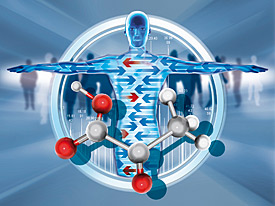Metabolomics is the multiparallel measurement of the levels of a large number of cellular metabolites. Metabolomics is the following step of genomics and proteomics. There are about 25,000 genes, the majority is unknown functions. There are about 1,000,000 proteins, most of which are unstudied.
 Metabolome is the complete collection of small molecule metabolites in a cell, organ, tissue or organism which includes endogenous and exogenous molecules as well as transient or constant theoretical molecules. It is defined by the detection technology and their size is always ill-defined. These metabolites are low-weight molecular compounds produced in the course of processing raw materials. Some familiar metabolites including cholesterol, glucose, sucrose, fructose, amino acids, lactic acid, uric acid, drug metabolites, ATP, ADP, legal and illegal. All these can be produced in metabolic pathways, such as the citrate cycle for oxidation of glucose. These pathways contain important information about the amount of each metabolite are stoichiometric equations illustrate how much material is produced in a given reaction; i.e., mass balance and rate equations govern the speed at which reactions takes place, and the location of the Gibbs equilibrium which gives metabolomics an edge.
Metabolome is the complete collection of small molecule metabolites in a cell, organ, tissue or organism which includes endogenous and exogenous molecules as well as transient or constant theoretical molecules. It is defined by the detection technology and their size is always ill-defined. These metabolites are low-weight molecular compounds produced in the course of processing raw materials. Some familiar metabolites including cholesterol, glucose, sucrose, fructose, amino acids, lactic acid, uric acid, drug metabolites, ATP, ADP, legal and illegal. All these can be produced in metabolic pathways, such as the citrate cycle for oxidation of glucose. These pathways contain important information about the amount of each metabolite are stoichiometric equations illustrate how much material is produced in a given reaction; i.e., mass balance and rate equations govern the speed at which reactions takes place, and the location of the Gibbs equilibrium which gives metabolomics an edge.
The purposes of metabolomics are timely detection of disease, such as necrosis, alzheimer’s, and inflammation, evaluation of toxicity (especially liver toxicity) in new drugs, diet strategies, and drug testing, elucidating biochemical pathways.
The importance of metabolomics are >95% of all diagnostic clinical assays test for small molecules,89% of all known drugs are small molecules in which 50% of all drugs are derived from pre-existing metabolites, 30% of identified genetic disorders occupy diseases of small molecule metabolism where as small molecules serve as cofactors and signaling molecules to 1000’s of proteins. Metabolites are the canaries of the genome and it is more time sensitive than other “omics”.
Metabolomics applications are toxicology testing, clinical trial testing, fermentation monitoring, Food and beverages testing, Drug phenotyping, water quality testing, petrochemical analysis, genetic disease testing, transplant monitoring and nutritional analysis.
